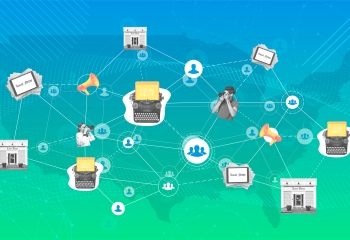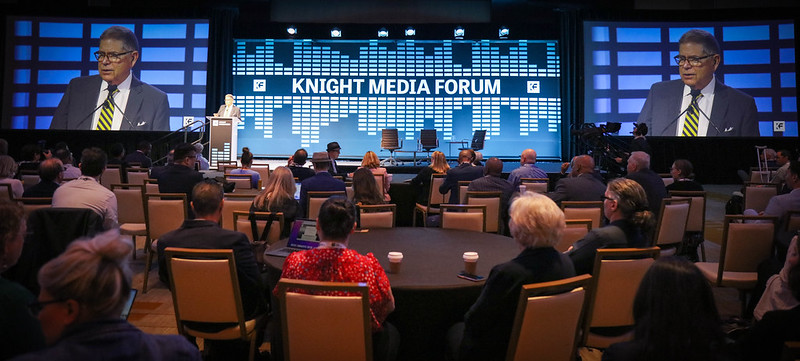
A Guide to Resources for Local News Publishers of Color
Grants, training, associations and more that can help legacy and new publishers
Communities of color need to have strong, sustainable local news outlets to cover them in a fair, equitable way. While Black, Hispanic, Asian and Native newspapers, TV and radio have a long history, the shift of ad revenue to tech platforms has hit many of them hard – with the added difficulties of pandemic-induced losses in ads and events. New digital publications are springing up in response to community needs, but often without the resources available in wealthy, white communities.
If the so-called mainstream local news publishers aren’t doing the job covering these communities of color, how can funders and journalism associations better support the publishers who have been doing the job for decades and the new startups that are starting to gain a foothold? The racial reckoning in media has led media foundations, associations and training programs to reset their priorities to put publishers of color in the spotlight. That’s a welcome change, even if the growing number of initiatives will only address a small portion of publishers across the country.
Ron Burke is focused on national sales and business development for the National Newspaper Publishers Association, otherwise known as the Black Press, and is the trade association for Black-owned community newspapers. He agreed that funding has increased somewhat for Black press in the past year, but it’s still not enough.
“The issue is that it’s not touching all of our members, just a few of them,” Burke told me. “We have 230 members, and I would say through all these funding opportunities, there’s maybe 15 or 20 of our members that have been able to take advantage of those… It’s not a criticism or a bad thing. But what about the ones that aren’t included? How can we get everyone included?”
I talked with a mix of legacy and digital publishers of color and associations to try to ascertain which resources are really moving the needle for publishers, helping to support them and their communities. And I also wondered what’s missing, where are the gaps? This Guide is meant to help as a starting point for publishers to explore some of the better resources in the hope that there will be more to come.
Grants & Funding
During the pandemic, many journalism funders have stepped up to support more local news outlets in general, and more publishers of color in particular. Money can come from national foundations, local and family foundations; large donors and philanthropists; and even local organizations that sub-grant money from larger foundations. There are three categories for these funders:
1) New grant programs tailored to publishers of color;
2) existing foundations changing their priorities; and
3) groups of local funders banding together to support news organizations during the COVID-19 pandemic.
Foundations can offer support beyond grants. As Alvaro Gurdián, vice president of operations at La Noticia in Charlotte, N.C., told me, “Not everything is direct dollars. Sometimes it’s a connection. A foundation connected me to this bank because they’re philanthropic. That’s valuable, and it can be repeated in a pattern. Getting an intro is important.”
Here are some grant and funding programs making a difference for publishers of color:
- Racial Equity in Journalism Fund at Borealis Philanthropy: Raised $3.6 million from Craig Newmark Philanthropies, Democracy Fund, the Ford Foundation, the Google News Initiative, the American Journalism Project and the News Integrity Initiative at the Craig Newmark Graduate School of Journalism at CUNY; granted $2.3 million last year to 16 news organizations serving communities of color.
- Black Press Grant Program: The National Association for Black Journalists (NABJ) will give grants to freelance reporters and producers at Black-owned media outlets to cover the COVID-19 pandemic, vaccines and education, with $300,000 in funding from the Chan Zuckerberg Initiative. The grant term runs until the end of 2021.
- Knight Foundation’s local news initiative: Knight has pledged to spend $300 million to support local news over five years, and its grantee initiatives sub-grant money to local newsrooms. These include:
- Report for America, which helps place reporters in newsrooms, and has doubled the number of partner newsrooms operated by journalists of color, and created 19 reporting positions covering indigenous affairs; and will bring on 12 Black-owned newsrooms in 2021.
- Solutions Journalism Network, which has made diversity, equity and inclusion a key tenet of grants to newsrooms to do work with a solutions lens;
- American Journalism Project, which is a venture philanthropy that’s raised more than $50 million and given out more than $12 million in grants, including to NOISE Omaha, City Bureau, Documented, MLK50 and Capital B.
- Lenfest Institute for Journalism has a News Philanthropy Network with trainings and support for publishers, as well as the Knight-Lenfest Local News Transformation Fund which has given out numerous grants to publishers of color, especially with its Philadelphia COVID-19 Community Information Fund.
- Google News Initiative has pledged to spend $300 million to support local news, has given out emergency grants during the pandemic and recently had a fund to support projects that countered misinformation about COVID-19 vaccines.
- Facebook Journalism Project has also pledged $300 million to support local news, and has run a number of accelerators to support subscriptions and memberships for publishers. This year, more than 55% of accelerator participants are owned or led by publishers of color, and there was an accelerator focused specifically on publishers of color.
- Democracy Fund has a vibrant and growing focus on the Public Square, including local journalism, and recently made a commitment to expand the proportion of grantees led by or serving people of color. It also created the great Journalism DEI Tracker and Journalism DEI Wheel in partnership with Dot Connector Studio.
- NewsMatch is a fundraising program for nonprofit newsrooms to get matching funds from national foundations for fundraising campaigns in November and December. Last year, NewsMatch helped newsrooms raise more than $47 million, with nearly a fifth of participating publishers serving communities of color or being led by people of color.
- Detroit Journalism Engagement Fund aims to strengthen local news in Detroit and Southeastern Michigan by supporting various projects designed to help journalists engage community members in the reporting process. It was funded by Knight Foundation, Ford Foundation and the Community Foundation for Southeast Michigan.
- NewsStart at West Virginia University helps legacy community newspapers find new owners, a problem that may be an issue with Black- and Brown-owned newspapers that don’t have a succession plan in place.
- Black Public Media’s 360 Incubator+ helps fund startup projects in broadcast and digital formats “centered on the Black experience.” The program is produced by Black Public Media, and offers grants up to $150,000.
More resources: INN Network Philanthropy Center, Foundation Maps for Media Funding, Indigenous Ways of Giving + Sharing and the Journalism Grants Directory.
Associations / Communities
Journalism associations that cater to journalists of color have helped push larger news organizations to become more diverse, while also offering training, networking and regular conventions. At one point, the main associations for Black, Latinx, Asian and Native journalists formed a “Unity” group that tried to work together, but that effort unfortunately failed. Recently, newer allies in local news, Local Independent Online Publishers (LION) and the Institute for Nonprofit News (INN) have made strides in offering discounted or free membership to publishers of color (legacy and startups) and put their concerns front-and-center in virtual conferences and case studies.
A recent addition to those efforts is the DEI Coalition Slack channel from OpenNews that includes allies as well as journalists of color.
“We sincerely hope that [the DEI Coalition] can help connect the dots between spaces, as well as other spaces who aren’t yet connected to each other but want to be, as they need it,” wrote Sisi Wei of OpenNews. “We hope that truly, it can serve as a tool for the community to create change — by bringing allies together so that they can fight together and plan movements together.”
Here are some long-standing and newer entries among the associations and networks that support publishers of color:
- National Newspaper Publishers Association (NNPA): Offers advocacy for 200+ Black-owned newspapers, along with a newswire and digital ad network. Its annual conference is online and free to attend this June.
- National Association of Hispanic Publishers (NAHP): A cousin organization to NNPA, the NAHP has Spanish-language publications as members in 41 markets around the country, and offers advocacy, awards and an annual conference.
- Association for Alternative Newsmedia (AAN): The association serves alt-weekly magazines and digital websites but has made a push to include more publishers of color. It is also working on a large collaboration with NNPA, NAHP and Google News Initiative with a focus on digital sustainability.
- Native American Journalists Association (NAJA), Asian American Journalists Association (AAJA), National Association of Hispanic Journalists (NAHJ) and National Association of Black Journalists (NABJ): These groups are targeted more to the editorial and journalism side instead of the business and publishing side. They offer a mix of training programs, conferences, advocacy and career services.
- Local Media Association (LMA): Represents a mix of 3,000 local newspapers, radio, TV and digital outlets, and helps them with training, conferences and webinars. Recently helped publishers with a special COVID-19 fundraising effort, created the Word in Black collaborative and has a Fund for Local Journalism that supports investigative journalism for publishers serving communities of color.
- Institute for Nonprofit News (INN): Focused on online nonprofit news organizations, INN has made a major shift to support publishers of color, taking a deep look at the diversity of its members and itself, along with a special online conference focused on racial equity last year. The group also has a Springboard program for nonprofit startups.
- LION Publishers: Mostly for-profit online publishers, with a good portion of nonprofits, LION has made a big push to support more publishers of color, especially with its focus on startups. That includes the Tiny News Collective and the comprehensive GNI Startups Playbook. There’s also a News Entrepreneur Community on Slack.
- Online News Association (ONA): Focused on editorial innovation, it has a large annual conference and local chapters. Two relevant programs are the HBCU Digital Media Fellowship and Journalism Mentorship Collaborative.
More resources: Vision25: Building Racial Equity in Newsrooms, DEI Coalition on Slack, Center for Community Media at CUNY and SembraMedia’s Online Festival.
Training / Fellowships
Many of the associations mentioned above have training programs for journalists, but there also are a number of organizations that offer fellowships or specialized training for publishers and entrepreneurs. Many of these programs were developed specifically for people of color, while others have made this their focus lately. And as Scalawag publisher and executive director Cierra Hinton told me, it’s important to consider leadership and management training programs as well.
Here’s a selection of great training and fellowship programs:
Maynard Institute: Along with diversity training programs, there’s the fantastic Maynard 200 fellowship that includes tracks in executive leadership, media entrepreneurship and storytelling. It’s a free, year-long program that includes mentoring and training for the chosen fellows.
Ida B. Wells Society for Investigative Reporting: The Society has a membership program, virtual workshops and a fellowship program in New York in partnership with the New York Times, all of which help more journalists of color become investigative reporters.
NNPA Foundation: Offers a summer internship program at Black newspapers as well as a scholarship fund to help college students financially who are interested in studying journalism.
John S. Knight Journalism Fellowships: Based at Stanford University, the JSK fellowships typically included a school year at the University, but have shifted during the pandemic to a virtual Community Impact Fellowship that focuses on solutions for better coverage of communities of color.
Table Stakes: Focuses on helping legacy media organizations develop change management skills and more sustainable business models. Programs are run by the American Press Institute, Poynter Institute, Arizona State University and the University of North Carolina, and they partnered with Maynard Institute to infuse DEI into the program’s principles.
Media Transformation Challenge: Started as the Punch Sulzberger Program at Columbia, this is now run by Poynter Institute and is a year-long program costing $28,500 focused on leadership transformation and solving core problems for media organizations.
News Revenue Hub: The Hub is a membership program that provides a range of services for publishers looking to increase revenues. They provide custom consulting and training on everything from email marketing, donation processing, UX analysis and culture change coaching.
Collaborations
Collaborations are becoming a way for publishers of color to work together to create deeper editorial, community engagement and fundraising opportunities. For newsrooms interested in starting and managing their own collaborations, there’s a great Collaborative Journalism Handbook from the Center for Cooperative Media and Project Facet. It’s important to note that in collaborations between more corporate media and publishers of color, there is often an uneven exchange of work and credit, so refer to Angilee Shah’s guide to building equity in journalism collaborations.
Beyond collaborations with other news outlets, The AFRO’s Toni Draper noted her extensive list of collaborations with local and national nonprofits such as the Baltimore City Public Schools, Black CEO, NAACP and Youthworks.
Here are some notable collaborations including publishers of color:
Word in Black: Started by the LMA, this collaboration of 10 Black-owned media publishers has taken on finding solutions to systemic racial inequities, with a focus on the impact of the pandemic on education in African-American communities. They plan to take on future topics such as voter suppression, police reform and health disparities.
Tiny News Collective: A new initiative from LION Publishers and News Catalyst, the Collective aims to launch 500 local newsrooms focused on unserved and underserved communities in three years. The startup newsrooms will be able to pay $100 per month for a tech platform, training, legal assistance and more – with a Launch Fund for the initial cohort of publishers with support from Google News Initiative.
Solutions Journalism Network: Has a Local Media Project that has helped create collaborations with a solutions lens in communities such as Charlotte, New Hampshire and Wichita. (You can find all these collaborations on our Civic Bright Spots Map.) These collaborations typically include a mix of different types of newsrooms, including Spanish-language publications, as well as partnerships with community organizations. Resolve Philly is a great example of a collaboration that serves communities of color and takes on important issues for them.
What’s Missing
Even with the growing number of resources for publishers of color, many people I spoke with mentioned that these are just a drop in the bucket compared to what’s needed. Yes, there are more grants from local and national foundations – but more is required. And as La Noticia’s Gurdián told me, “I’m happy to see a lot of efforts supporting startups, and it’s not as sexy to help those that are already there.” He thought one missing element was the accelerators that get media organizations run by one or two people up to the next level.
More relevant frameworks for assessment are also still needed. Kate Moos, managing director for Sahan Journal, told me that many national funders were still focused on website metrics and the size of the audience. “We need a better way of evaluating the scale of impact that is being achieved by BIPOC-led media, and a more vigorous movement to provide working capital to organizations that are transforming journalism and serving BIPOC communities.” She especially lauded the work of the Racial Equity in Journalism Fund and its outgoing program director Tracie Powell, which offered operational support for newsrooms.
What’s missing in this Guide? Drop me a line at [email protected] and I will update this roundup.
Mark Glaser is a consultant and advisor with a focus on supporting local and independent news in America. He was the founder and executive director of MediaShift.org, and is an associate at Dot Connector Studio, and innovation consultant at the New Mexico Local News Fund.
Recent Content
-
Journalism / Article
-
Journalism / Article
-
Journalism / Article














